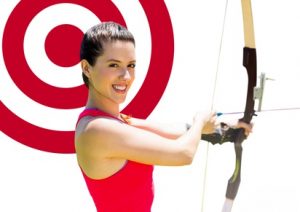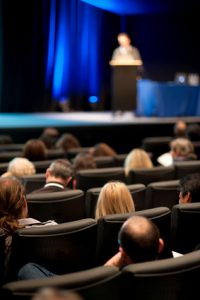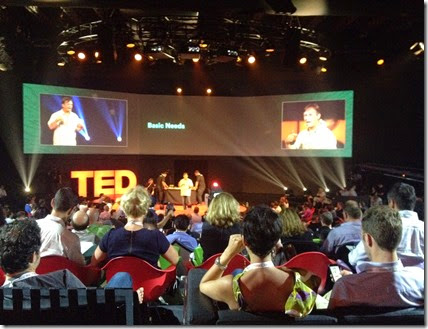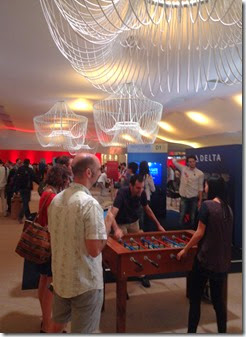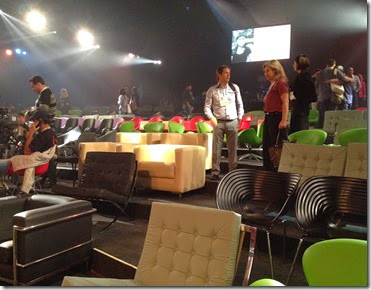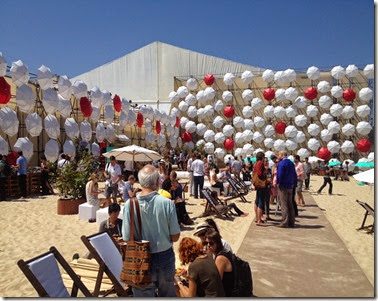 In February, I had my first “TED-ache” at TEDActive2011. TEDsters know all about TED-aches. They come with the “mind-mash” that is a TED conference. One minute its talks on quantum mechanics, biochemistry or brain science. The next its the latest in information technologies. And then you’re plunged deep into the ocean, taking a swim with seals alongside a nature photographer. Or you’re marvelling as a life-size horse puppet breathes and trots around the stage, and then Bobby McFerrin has you singing and laughing from your gut!
In February, I had my first “TED-ache” at TEDActive2011. TEDsters know all about TED-aches. They come with the “mind-mash” that is a TED conference. One minute its talks on quantum mechanics, biochemistry or brain science. The next its the latest in information technologies. And then you’re plunged deep into the ocean, taking a swim with seals alongside a nature photographer. Or you’re marvelling as a life-size horse puppet breathes and trots around the stage, and then Bobby McFerrin has you singing and laughing from your gut!
This is no ordinary conference. It stretches you to go where you would likely not go if just browsing the talks on TED.com. Most people listen actively to every single talk. And the beauty comes in the meaning you make for yourself as you listen to talks on a great diversity topics and begin to see patterns; to make connections; to find learning where you might least expect it.
On the journey home, I tried to create a mindmap as I read through all my notes (without which I would have retained but the merest fraction of ideas worth spreading). It was messy. However, perhaps even messier still has been my process of trying to sort all my tweets into some sort of coherence in order to share them here. From the mind-mash that was TEDActive, here are what are still a mish-mash of tweets (with some tweaks) to share my take-aways with you, clustered under some imperfect headings. The talks can be found here: TED2011 Talks
a. Perspective
b. Right, wrong and assumptions
c. Unintended consequences
d. The need to encode ethics in algorithms
e. Innovation and counter-intuition
f. Instrumental information: visualizing systems
g. Collective wisdom for change
h. Art for social change
i. Crowd-voicing
j. Collaborative creativity
k. Leveraging learning
l. Breathtaking medical breakthroughs
m. Miscellaneous communication products and technologies
a. Perspective
Astronaute in space Cady Coleman speaks perspective & the importance of connectedness & value of the earth as she circles once/18 mins.
“If a chunk of metal can be in two places at the same time, you could be. We have to think about the word differently as an individual” Physicist Aaron O’Connell.
Physicist Aaron O’Connell: “Everything around you is connected & that’s the profound weirdness of quantum mechanics.”
In a gfa-1 microbe in Mono Lake CA, arsenic seems to function as phospherous in a cell. Evidence of alternative biochemistry on our planet? It would change our definition of habitability elsewhere… Felisa Wolfe-Simon
We can only find what we know how to look for. For Felisa Wolfe-Simon that’s learning to look for alternative biochemistry on earth.
Edith Widder’s eye-in-the-sea explores bioluminescent deep ocean life & language. “Don’t know what they’re saying… I think its sexy!”
Paul Nicklen chokes up recounting leopard seal stories from his polar photo missions for Nat Geog and shows pictures of the white ‘Spirit’ or ‘Kermode’ bear – only 200 left on the planet! Save sea ice; its as important as soil.
Swiss explorer Sarah Marquis: “I dont want to put people back in nature; I want to put nature back in people”. “Let your soul touch the earth…. go walking.”
RachelSussman photographs living things >10’000 years old. “If you didn’t know what you were looking for, it would be easy to overlook something other megaflora were grazing on before extinction”.
b. Right, wrong and assumptions
“Trusting too much in the feeling of being right can be very dangerous and create huge tactical and social problems as we believe our beliefs reflect reality and make huge assumptions to explain people who disagree with us: assume their ignorant, idiots and/or evil, leading us to treat each other terribly, missing the hole point of being human. The miracle of the mind is that you can see the world as it isn’t.” Kathryn Schulz
“We need to learn to step outside of rightness, look around at one another and the vast complexity of the universe and say: ‘Wow, maybe I’m wrong!The system tells us getting something wrong means there’s something wrong with us. We learn the way to succeed is to never make any mistakes.” Kathryn Schulz
“How does it feel to be wrong?” Asks Kathryn Schulz. “Wrong. You’re answering the question, ‘How does it feel to realize that you’re wrong?’ It feels like being right to be wrong until until you realize you’re wrong.”
Daman Horowitz speaks about his work in prisons giving philosophy classes & the importance of questioning what we believe and why we believe it, including exploring wrongness. “What is wrong? Maybe I am!”
Magician Franz Harary demonstrates playing with glitches in peoples minds that distort and manipulate thoughts, using magic to fake technology that doesn’t exist.
c. Unintended consequences
Evolution will be guided by us in the future, thanks to genetics. What will we choose? More competitive? Empathetic? Creative? “If anything had the potential for unintended consequences, this is it!” Harvey Fineberg
We cannot foresee all consequences. But how can we close the gap between capabilities & foresight? Edward Tenner’: “Learn meticulously from unintended consequences & chaos”.
Edward Tenner: An example of unintended consequences = adding lifeboats to a ship, making it more unstable and resulting in tragedy.
“We are at a threshold moment: a single global brain of almost 7 billion individuals learning collectively at warp speed = very powerful and potentially very dangerous. Nuclear weapons are evidence.” David Christian
Looking at ‘big history’ shows us the power of collective learning and the dangers that come with it. Studying this will help all students make better decisions in the future. David Christian
d. The need to encode ethics in algorithms
“We need new info (Internet) gatekeepers to encode ethic responsibility into their (Facebook, Google…) algorithmic code & give us some control” El Pariser.
Speaking of Facebook and Google, Eli Pariser asserts: “’Personalized algorithmic filter bubbles are throwing off balance our info diet, converting it to info funk food.’
“The demise of guys is a consequence of arousal addictions stimulated by the internet & video ‘porning'” – Philip Zimbardo
e. Innovation and counter-intuition
“The greatest time for game-changing innovation was The Great Depression.” Edward Tenner
“When you train people to be risk averse, they are reward challenged”, said Morgan Spurlock in his talk encouraging the embracing of transparency. He sold the naming rights to his talk.
Inspiring talk by Kalia Colbin about reimagining Christchurch: “10 days ago my be the beginning of the demise of my city, but in the rubble their may be promise”. Help with ideas at www.reimaginechristchurch.org.nz.
Do something good for the city and we’ll give you more land, says Malaysia to property developers as incentive. Thomas Heatherwick does, with buildings that leave more ground for the forest.
For the first time in history not one child in Utter Pradesh & Bihar (northern India) has Polio. New vaccine + resolve + tactics = a unique eradication opportunity. Bruce Aylward
Chefs Hamaru Contu & Ben Roche introduce “Disruptive Food Technology”: from the Future Food science lab: tricking taste buds we can reduce energy & waste http://planetgreen.discovery.com/tv/future-food/.
Bill Ford asserts ingenuity in mobility solutions is not only about our movement, its also about access to food and healthcare. Smart cars, smart parking, smart signalling and smart phones all integrated in new smart mobility system is the future.
A leap in thinking is needed to avoid global gridlock if the population reaches the predicted 9 billion in 2044. Real time data is needed for a new mobility system. Bill Ford
“If we sped up cars in our cities by 3mph, we would reduce by 11% the emissions of our transport system.” Counter-intuitive! Luis Cilimingras, IDEO (formerly FIAT)
Speaking of cars actively driven by the blind (unveiled Jan 2011 http://is.gd/ruV8l1): “Technology will be ready, but will society be ready?” Need system change. Dennis Hong
f. Instrumental information: visualizing systemss
“As the world becomes increasingly instrumented and we have means to connect the dots, we can see interactions not previously visible with profound implications for us as individuals” Deb Roy,
Deb Roy set records in home-video hours to reveal patterns linking words to context and identifying feedback loops as his son acquired language in his Human Speechome Project http://j.mp/ePanlq.
Collaborating with scientists, Rajesh Rao tries to use computer modelling to decipher the last major undeciphered ancient script – Indus. Does it boil down to picture of ‘bee’ + ‘leaf’ = ‘belief’?
Ebs and flows in US flight patterns are visualized, providing powerful communication www.aaronkoblin.com/work/flightpatterns/
Carlo Ratti, MIT SENSEable City Lab, uses pervasive technologies to track trash in an investigation into the “removal-chain”. Listening to Haydn’s ‘Farewell’ Symphony (45), he shows us trash doesn’t leave, just moves! http://senseable.mit.edu/trashtrack/
g. Collective wisdom for change
Students tackle 50 interlocking systems problems learn how not to follow short term destructive paths and learn how to think about World Peace long term, learning right and wrong through their experience. John Hunter
John Hunter asserts very openly that the collective wisdom of his 4th grade students is so much greater than his own. He trusts them to solve world problems, practicing with his World Peace role-play game.
US General Stanley McChrystal talks about changes in leadership with distributed technologies and the inversion of expertize as old ‘leaders’ are less familiar wit the technologies required.
h. Art for social change
Under house arrest in Shanghai, Ai Weiwei speaks via video of art for social change & the creation of a civil & more democratic society in China despite no party willingness.
Street Artist JR’s wish: “Stand up for what you care about by participating in a global collaborative art project. And together we’ll turn the world INSIDE OUT”: www.insideoutproject.net
Women Are Heroes project by street artist JR: www.womenareheroes.be In Kibera “we didn’t use paper (on the rooves), because paper doesn’t prevent the rain from leaking in the house but vinyl does.”
“It doesn’t matter today if it’s your photo or not. The importance is what you do with images… We decided to take portraits of Palestinians and Israelis doing the same job. They all accepted to be pasted next to the other.” JR
i. Crowd-voicing
Human right activist & TED Fellow Esra’a Al Shafei presents www.crowdvoice.org – a project of MidEast Youth tracking voices of protest around the world using crowdsourcing.
Wael Ghonin: Egypt saw extreme tolerance, Christians & Muslims protecting one another praying. “The power of the people is much stronger than the people in power”.
Surprise talk by Wael Ghonim on the Egyptian revolution: “No one was a hero because everyone was a hero.”
“We cannot have a well-functioning democracy if there is not a good flow of information to citizens” El Pariser.
Head of Al-Jazeera, Wadar Khanfar: “The democratic revolution sweeping the Arab world is the best chance to see peace. Let us embrace it.”
j. Colloborative creativity
“Electronic communication will never be a substitute for someone who face to face encourages you to be brave and true” Marc Martens talking of the powerful “Glow” public art playground http://glowsantamonica.org/. Public art to connect people is at the heart of the Santa Monica ‘Glow’ project.
Face ache follows the Bobby McFerrin session. “Unparalleled joy” was in the programme! Playing along with Bobby’s creative spontaneity warmed everyone’s hands, voices and hearts.
The lennonbus.org at #TEDActive – a non-profit mobile recording studio dedicated to providing students with opportunities to make music and video projects.
eyewriter.org – an ongoing collaborative research project using completely open source technology to empower people suffering with paralysis to draw with their eyes. Mik
Co-creating a music video through crowdsourcing: Aaron Koblin describes www.thejonnycashproject.com: a living, moving, ever-changing portrait as people all over the world contribute portraits to the collective whole.
Aaron Koblin: “Interface can be a powerful narrative device”, showing a crowd-sourced video, which when viewed is unique to each viewer www.thewildernessdowntown.com/
Conductor Eric Whitacre’s “Lux Aurumque” gives voice to a virtual choir – http://ericwhitacre.com/the-virtual-choir. The upcoming project received >2050 videos online from 58 countries.
k. Leveraging learning
Project V.O.I.C.E. – lovely project by Sarah Kay uses poetry as a way to entertain, educate & inspire. List 10 things you know to be true. Sharing these lists – who has the same? / opposite? / who heard something never heard before? / heard new angles on what you thought you knew? Sarah Kay
Make a list “10 things I should have learned by now.” Sarah Kay uses poetry to work through what she doesn’t understand with a backpack from where she’s already been.
Neuroscientist Antonio Damasio looks at the conscious mind: “There are 3 levels of self: The proto, the core & the autobiographical (past & anticipated future). We share the first 2 with other species.”
NYT Columnist David Brooks asserts emotions are the foundation of reason and, as social beings emerging out of relationships, we need to learn better how to read, listen to and talk about emotions.
Ed Boyden explores the brain signals that drive learning & describes the process of installing molecules in neurons and using light to turn on/off specific cells in the brain and treat neurological disorders.
“Personal perceptions are at the heart of how we acquire knowledge.” Autistic Savant, Daniel Tammet, shares insights from synaesthesia about colours, textures & the emotions of words & numbers.
29% greater retention from doodlers & better problem solving because it engages all learning styles – Sunni Brown. “The doodle has never been the nemesis of intellectual thought. In reality, it’s been one of its greatest allies.”
Khan Academy learning: self paced, interactive, peer-to-peer, encouraging trying & failing (like falling off a bicycle), and designed to be iterative and so avoid ‘swiss cheese’ gaps in education. Salman Khan
“By removing the one-size fits all lecture from the classroom, these teachers have used technology to humanize the classroom.” “What we’re seeing emerge is this notion of a global one-world classroom.” Salman Khan
“Kids 1 year from voting age don’t know butter comes from a cow. They’re not stupid. Adults have let them down. Every child has the right to fresh food at school & food education as a requirement. It’s a civil right” Jamie Oliver
Jamie Oliver’s exciting new announcement about the future of the Food Revolution: http://bit.ly/hbRmGM #TED
Alison Lewis presents fashion technology, encouraging DIY “Switch Craft” projects blending sewing and electronics to bring handiwork into the 21st century: http://blog.alisonlewis.com/?p=541.
Fiorenzo Omenetto reinvents something that’s been around for millennia. Learning from silk worms, he reverse engineers the cocoon turning water & protein into material with environmental & social significance.
A seed cathedral, inspired by Kew’s seed bank, jurassic park & play doh mop-tops is Thomas Heatherwick’s stunning London Pavillion @ Shanghai: www.heatherwick.com/uk-pavilion/.
Learn a second language in Second Life: an alternative emersion process that works with the 5 stages of second language acquisition and the mastery of the 4 language skills, says Jeong Kinser.
Indra Nooyi talks about Pepsi’s Refresh University to sustain & multiply social change emerging from www.refresheverything.com: stories, lessons & ‘how-to’ online + leadership skills training.
l. Breathtaking medical breakthroughs
Luke Massella is living proof of Anthony Atala’s regenerative organ work. He was one of the first ten people to receive a ‘printed’ kidney. 3D printed organs are the next frontier in medicine.
Eythor Bender showcases his incredible exoskeletons, which enable the paralyzed to walk again.
m. Miscellaneous communication products and technologies
The effects of HIV can be reversed. Watch this powerful ad from the Topsy Foundation: http://t.co/lLph2Or via @youtube.
A compelling video for the genocide-awareness www.onemillionbones.org/ project by Art Activist TED Fellow Naomi Natale #TED: http://youtu.be/FFukmsLLG0k.
Weforest.org’s “Lessons from a tree” video – narrated by Jeremy Irons – supports the “Buy2get1tree” campaign, working with corporate partners to save 2 trillion trees by 2014. Bill Liao
Kate Hartman creates devices that play with how we relate and communicate with ourself, others and nature. “Our bodies are our primary interaction with the world”.
The Handspring Puppet Company breath life into a larger than life War Horse puppet on stage using masterful “emotional engineering” and “up to date 17th century technology to turn nouns into verbs”.
Mike Matas demos www.pushpoppress.com/ – the first feature length interactive book and sequel to “Inconvenient Truth” – with Climate Change solutions. Blow on the screen to turn wind turbines!
A smart braille phone varying the height of a pixel instead of color to communicate information on “screen”: A concept of TED Fellow – SumitDagar.com.
Mattias Astrom demos C3, a new 3D mapping technology: http://www.c3technologies.com/
Bubbli – ambitious new startup seeks to change the way we record images with cameraphones. Terrence McArdle & Ben Newhouse.
Shea Hembrey invented 100 artists and imagined their art. http://www.sheahembrey.com/

